The most comprehensive guide to making no-fail smoked brisket from a champion pitmaster. Includes detailed steps for every type of smoker.
Smoked brisket is the king (or should I say queen) of meats when it comes to barbecue. When I first wrote this recipe and brisket smoking method in 2016, I was fairly new to the barbecue game.
Yet, it has been my go-to backyard smoked brisket recipe for years, because it works for me, and it’s worked for hundreds of you.
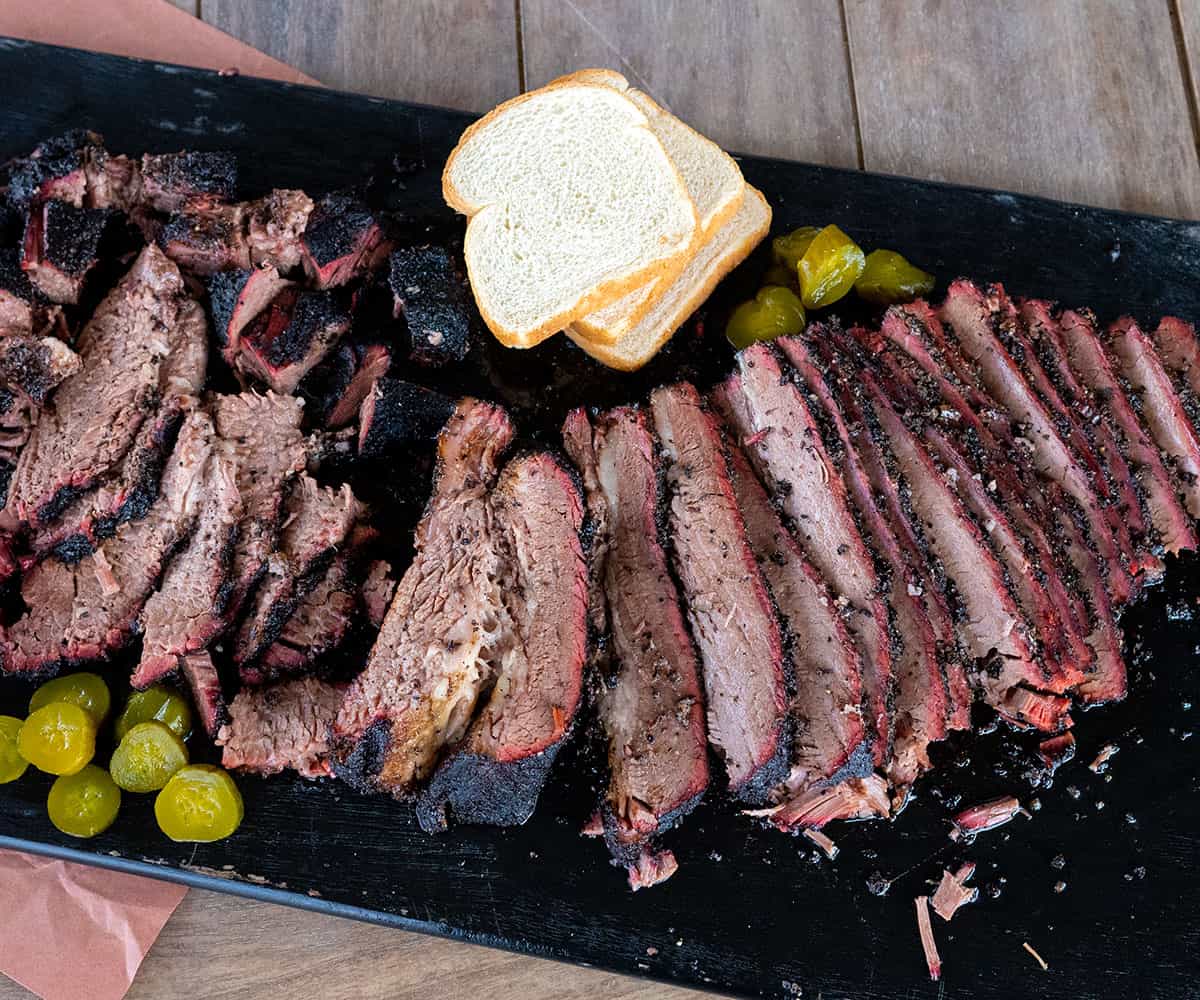
Save this BBQ Tip
Enter your email, and I’ll send this link directly to your inbox. Plus, you’ll get new BBQ recipes and tips weekly.
Fast forward several years, and I’m now a multiple time first place brisket champion on the competition circuit. My competition methods are slightly different, because those judges only take one bite.
But when I’m cooking a brisket in the backyard, where I know friends and family are going to dive in for second and thirds, I still follow this tried-and-true, no-fail method for making smoked brisket.
I have scaled back this article to get to the meat of how to smoke a brisket. But don’t worry, I didn’t get rid of all of the in-depth info. You can now find that in my smoked brisket guide.
It’s filled with answers to all of your brisket questions from selecting a brisket to trimming and seasoning all the way through the cook with methods for every type of grill.
Table of Contents
- What is brisket?
- What grade of brisket should I buy?
- Where to buy brisket
- Smoked brisket ingredients
- Equipment to smoke brisket
- What size brisket do I need?
- How to trim a brisket
- Smoked brisket rub & injections
- How to smoke a brisket
- What type of wood to use to smoke brisket
- Brisket fat side up vs fat side down
- How to smoke a brisket on a pellet grill
- How to smoke a brisket on a ceramic cooker
- How to smoke a brisket on a vertical smoker or drum smoker
- How to smoke a brisket on a charcoal grill
- How to smoke brisket on a gas grill
- How long to smoke a brisket
- How to smoke a moist, juicy brisket
- Smoked beef brisket internal temps
- Let your brisket rest
- How to make burnt ends
- How to slice brisket
- Frequently Asked Questions
- What to serve with smoked beef brisket
- Smoked Brisket Recipe
What is brisket?
The brisket is part of the chest muscle of the cow. It’s located just above its front legs. Unlike other primal beef cuts, the cow uses this muscle a lot, which is why it requires a certain cooking technique to break down the connective tissue.
BBQ Tips: Learn more about the brisket cut >>
What grade of brisket should I buy?
The U.S. Department of Agriculture grades cuts of beef based on their fat marbling. Marbling is the white streaks of fat that you can see among the red meat.
The more marbling a cut of meat has, the more flavorful and tender it will be.
- Select grade brisket – very little marbling; hard to keep moist moist.
- Choice grade brisket – moderate marbling; when you smoke the brisket slow and low at 225F degrees following this smoked brisket recipe, you should end up with beautiful results.
- Prime grade brisket – moderately abundant marbling, better flavor
BBQ Tips: Brisket grades explained >>
Where to buy brisket
Brisket can usually be found year-round at your local grocery store, Sam’s Club or Costco. I have found that most of the time the brisket at the grocery stores is graded as USDA choice; whereas the big box stores occasionally carry USDA prime.
You can also order briskets online from different farms and butchers. When ordering online, they usually arrive frozen, so be sure to work in a couple days to thaw your brisket when you plan your cook timeline.
The safest way to thaw a brisket is in the refrigerator. A 10-12-pound brisket will take 2-3 days to fully thaw in the refrigerator.
BBQ Tips: Where to buy quality brisket >>
Smoked brisket ingredients
Fortunately, the ingredients for smoked beef brisket are pretty simple. I’ll explain each component throughout this article.
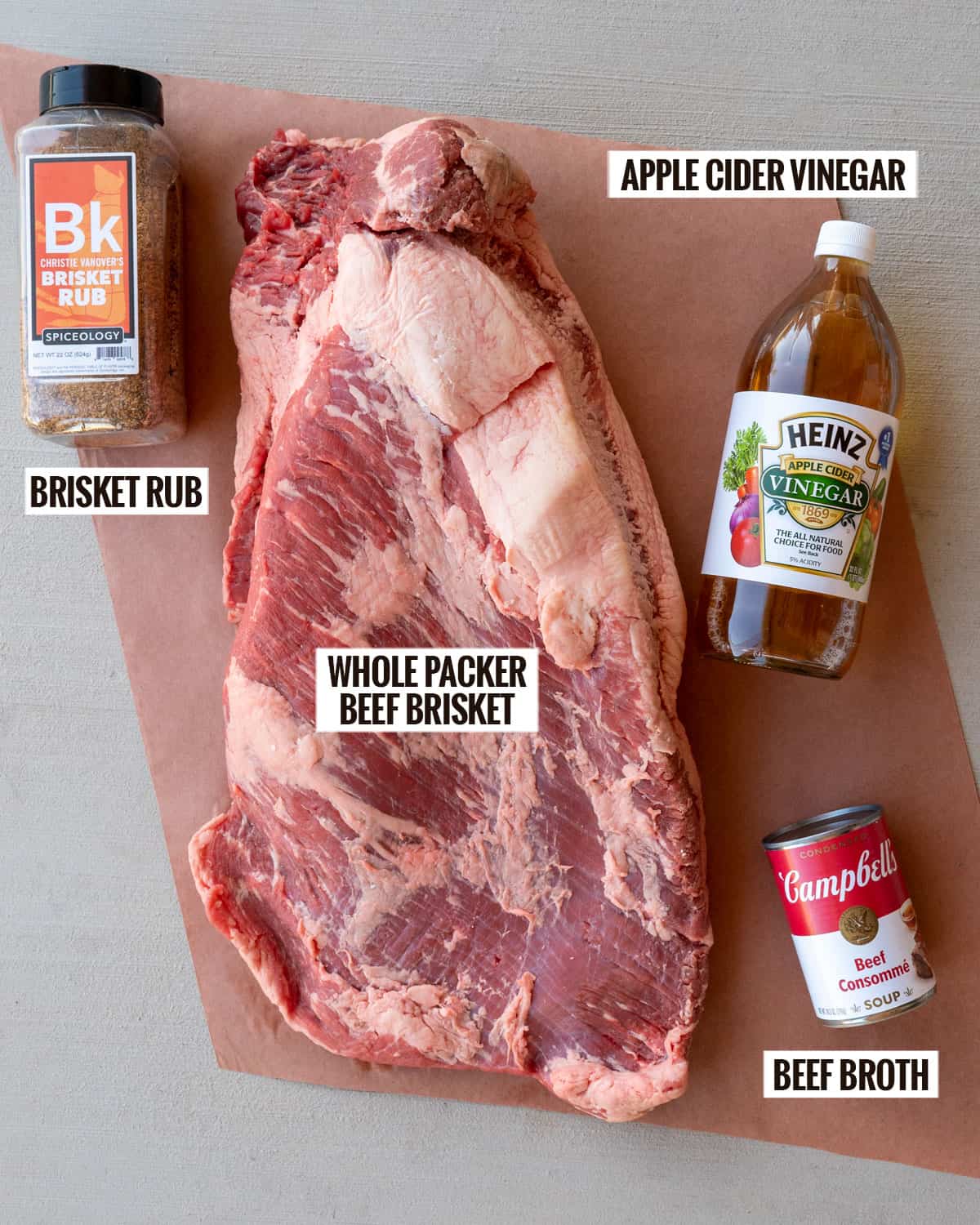
- Brisket: Look for a whole packer brisket. Select the best grade of brisket that fits your budget. I’ll talk about size below.
- Beef Broth: This will be used as an injection to add both moisture and extra beefy flavor. You can use beef broth or beef consume. Consume is a little richer.
- Brisket Rub: The Texas standard is kosher salt and pepper. Feel free to stick with that, or try any pre-made beef rub. My award-winning brisket rub will be available again soon.
- Apple Cider Vinegar: This will be spritzed on the brisket throughout the cook to add moisture and help build bark.
Substitutions: You can substitute the apple cider vinegar with water, beer or cola. I prefer the vinegar, because the tartness balances well with the fatty beef.
Equipment to smoke brisket
This list can look a little intimidating, at first, but you probably have most of these tools already. I just wanted to list them all in one place, so you could prep for your big smoke day.
- Large Cutting Board: Whole briskets are quite large, so it’s good to invest in a cutting board that can handle that large of a piece of meat.
- Boning and/or Butcher Knife: When trimming a brisket, I use both a Cutco butcher knife and a boning knife. The butcher knife helps to cut off the larger pieces of hard fat. The boning knife has flexibility which aids in removing the thin silver skin.
- Meat Injector: Use an injector to add more flavor and moisture to the brisket before it cooks.
- Smoker or Grill: You can smoke a brisket on any type of grill. Scroll down to see the techniques for a gas, charcoal and pellet grill.
- Charcoal or Wood Pellets: Select the fuel that works with your grill.
- Wood Chunks or Wood Chips: If using charcoal, add a couple wood chunks for added flavor. When cooking on a gas grill, you can create a foil pouch with wood chips or pellets.
- Spray Bottle: Several times during the cook, you’ll spray the brisket with liquid.
- Leave-In Meat Thermometer: As the brisket cooks, monitor its progress without opening the grill using a leave-in meat thermometer.
- Instant Read Thermometer: Not only is a Thermapen handy for testing the temperature throughout the cook, but how it glides in at the end is a key to knowing when a brisket is ready.
- Foil or Peach Paper: One stage of this smoked brisket cook is the Texas Crutch. That’s a technique used to lock in moisture and speed up cooking through the stall.
- Cooler: Once the brisket is done smoking, you’ll place it in a cooler without ice to allow the juices to settle. If you’re interested in upgrading from a cooler, most pitmasters who compete on the circuit use a Cambro.
- Towel: When holding the brisket in the cooler, wrap it in a towel, but be sure it’s one you don’t care about, because it will smell like smoke.
- Serrated Knife: Get perfect brisket slices by using a long serrated knife. This will help you cut through the bark.
What size brisket do I need?
If you’re smoking brisket for the first time, or you’re still getting the hang of it, I recommend starting with an 11-12-pound full packer brisket.
By starting small, your investment won’t be as large and the time commitment you’ll have to devote to the cook will be shorter.
If you’re cooking brisket for a larger group and you’re still kind of a novice, you could go with two 12-pound briskets versus trying to tackle a 22-pound brisket.
However, if you feel pretty confident about your brisket game, choose the size you need to feed your BBQ fans.
Plan on one pound of raw brisket per person, which will equal about a half a pound of cooked meat.
BBQ Tips: Brisket size buying guide >>
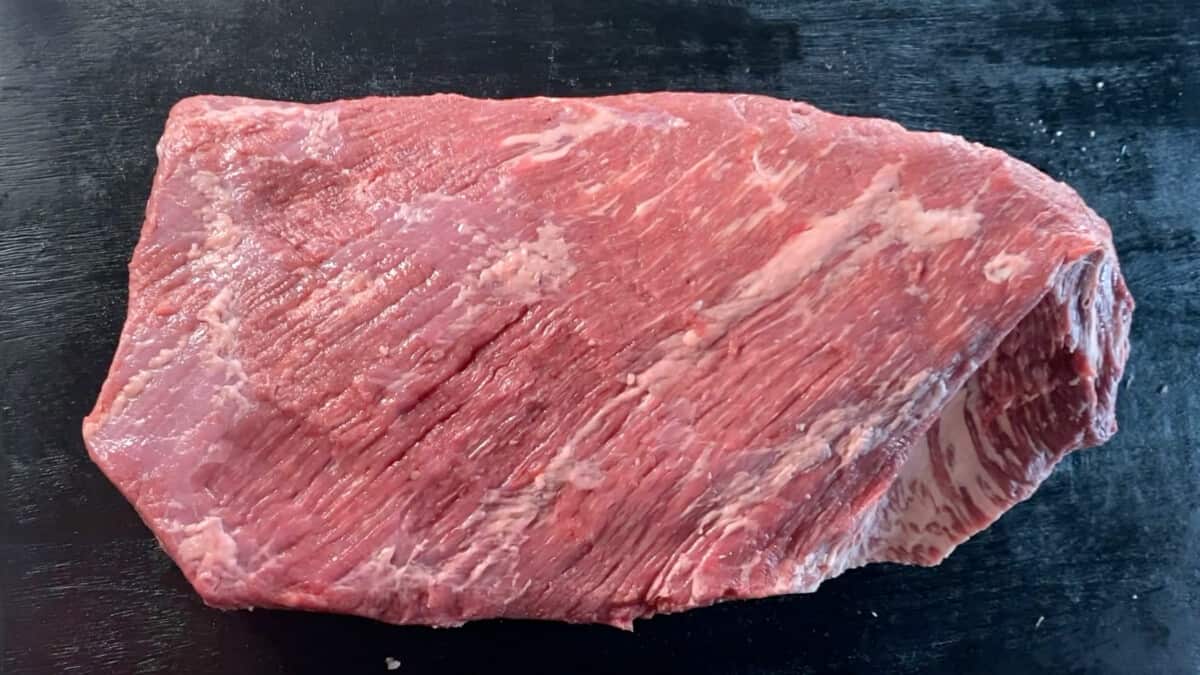
How to trim a brisket
All right. You’ve selected your grade and weight of brisket and now it’s time to get smoking…almost. First, you’ll need to trim it.
In the past, I have taken my brisket out of the plastic, rubbed it and thrown it straight on the smoker, but that’s not the best approach.
Fat is flavor, but in the case of whole brisket, there is plenty of fat marbled into the meat. And the hard fat cap will not render down during the cook.
Instead, that cap will actually block the smoke and rub from getting into the meat, so you need to trim it.
All you need is a really large cutting board and a sharp knife. I love using my Cutco butcher knife, but a boning knife works nice, as well.
Now that I’ve been smoking briskets for a while, I’ve learned that disposable plastic cutting boards work really well. I use them to trim all of my competition meats both before and after the cook.
BBQ Tips: Step-by-step brisket trim >>
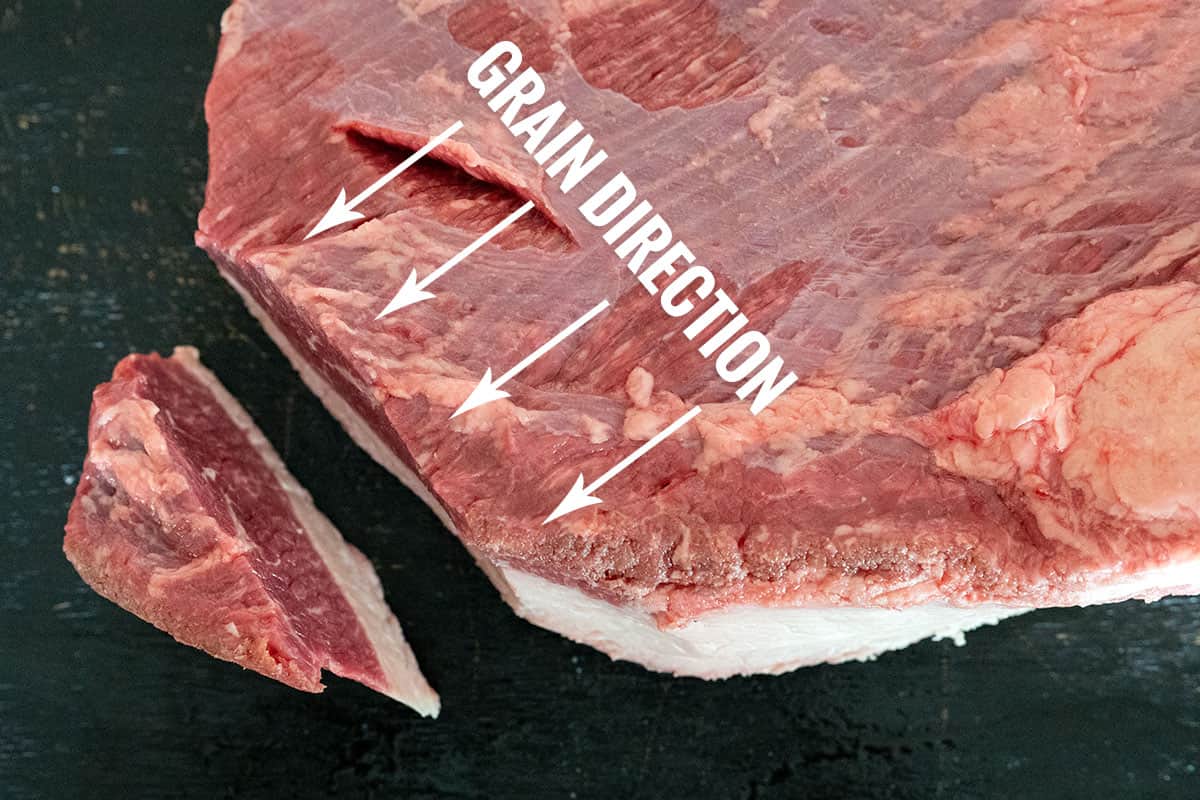
Give yourself a cheat guide for slicing your smoked brisket
During the trimming process, look at the flat muscle and pay attention to which direction the grain goes.
If you lift the brisket from the bottom and let it lay over your hand, you’ll see where the meat starts to separate. Those strips of separation are the grain.
When it’s time to slice the smoked brisket, you need to slice the meat against the grain for the most tender bite. However, once the meat is cooked, it’s hard to remember which way the grain was running.
I slice a little notch in the corner to help me remember where to start slicing the brisket.
What to do with leftover trimmings
The leftover hard excess fat can be rendered down to make beef tallow, which is a tasty fat substitute for making tortillas or biscuits or for cooking foods in a skillet or on a griddle.
For the meat trimmings, cut them into cubes and save them in the freezer. When ready, you can grind them up and make beef sausage or ground beef for burgers or spaghetti.
Should I separate the two muscles?
That’s completely optional. When I’m cooking in a barbecue competition, I do separate them every time, because I want to focus diligently on each muscle to create the best, winning bites.
The flat muscle will finish a little bit more quickly than the point muscle. By separating them, you can make sure the fat in the point is fully rendered without overcooking or drying out the flat.
I find this is really important when I’m cooking hot and fast brisket at around 300F degrees. When I’m cooking low and slow at 225F degrees like this no-fail smoked beef brisket recipe calls for, I leave the two muscles connected.
BBQ Tips: How to separate the brisket point and flat >>

Smoked brisket rub & injections
The prep is probably one of the most debated topics when it comes to BBQ brisket. Some swear by injecting their meat for tenderness; others prefer to keep the meat “au naturel.”
You’re welcome to go either way, but I recommend trying a brisket injection at least once. I think you’ll taste the difference. If you want to start simple, just inject the brisket with beef broth.
If you want do what the competitors do, combine 1/3 cup of phosphates with 1 bottle of water. Phosphates help retain moisture.
BBQ Tips: Brisket injection: tools, recipe and technique >>
Should I use a binder?
If you inject your brisket, you don’t need to use a binder like mustard or oil. The liquid of the injection will help the rub stick.
If you don’t inject your brisket, I’m still not a fan of using a binder. But if like binders, apply a very thin coating of vegetable or olive oil or yellow mustard.
The best smoked brisket rub
If you want to get into an argument with someone that’s almost as controversial as politics, talk to them about the best brisket rub.
Personally, I like a hint of sweetness and heat to my brisket rub. And plenty of barbecue judges do too. My Brisket Rub has earned me multiple first place brisket wins and will be available again soon.
In Texas, they don’t mess with their beef. The go-to rub for Texas-style smoked brisket is simply a blend of kosher salt and 16-mesh ground black pepper.
In the world of barbecue, you’ll often hear people use the term SPG. This simply means salt, pepper, garlic.
BBQ Tips: Rubs that taste great on brisket >>
How much brisket rub is needed
A good rule of thumb is to plan to have about 1/2 tablespoon of rub available per pound of untrimmed, raw brisket. If you’re cooking a 12-pound brisket, plan on having 6 tablespoons (1/3 cup) of rub.
BBQ Tips: How to season brisket >>
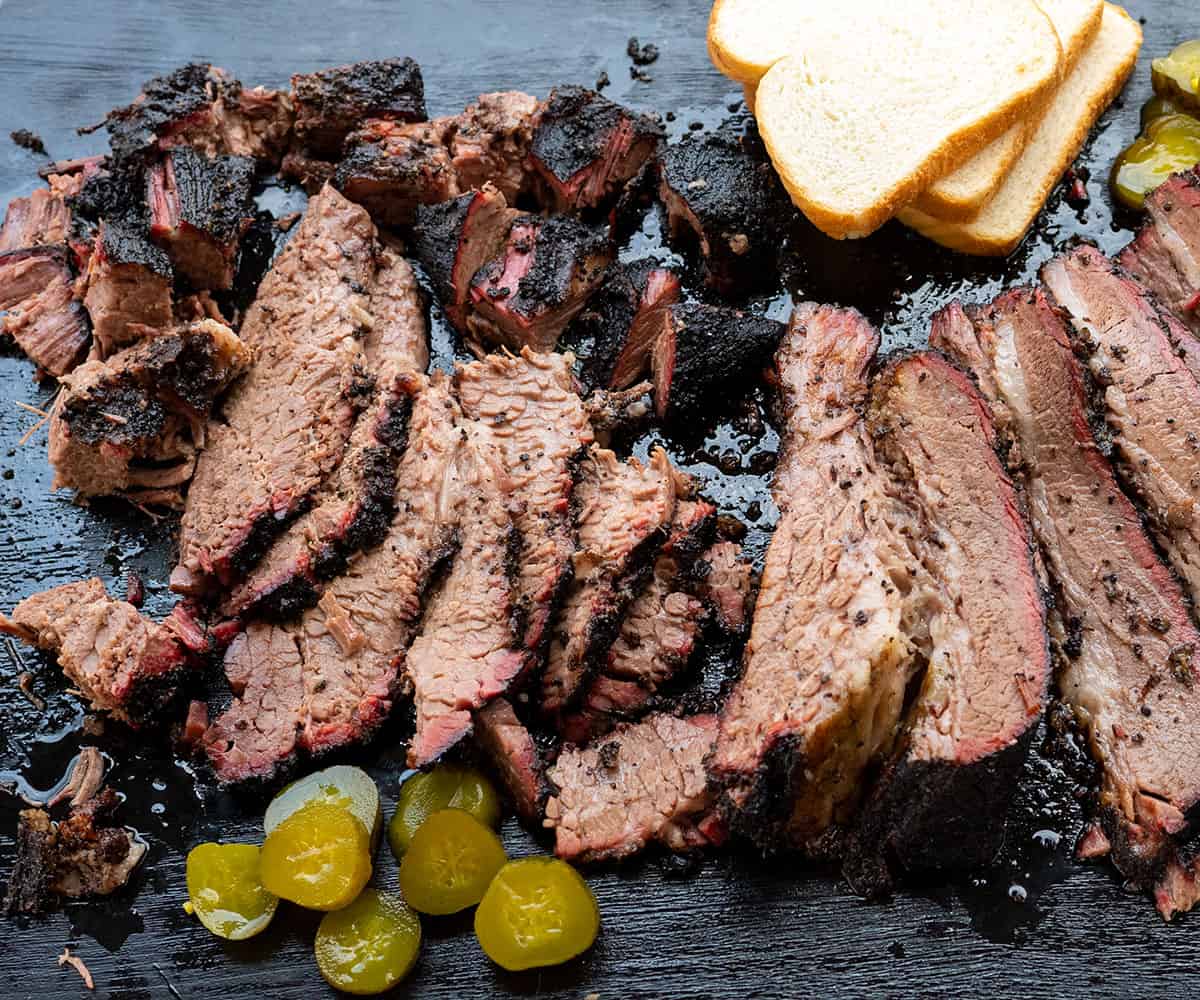
How to smoke a brisket
I’ve smoked brisket on a Big Green Egg, an offset barrel smoker, a vertical barrel smoker, an ugly drum, a PK Grill, a Weber Kettle and a pellet smoker. One of the easiest methods is on a pellet smoker, purely because it allows me to get on with my day without having to nurse the firebox for 8-12 hours.
Some may consider this a lazy approach, but honestly it’s a fail-safe way. There are so many distractions in life. When smoking a brisket, you have to be committed to it.
But don’t worry. If you don’t have a pellet grill, you can still create a no-fail brisket. I’ll walk you through the technique with each type of grill below.
The basic steps to smoking a brisket include:
- Trimming
- Injecting
- Rubbing
- Resting
- Smoking
- Wrapping
- Resting
PRO TIP: If you're short on time, you may want to try the hot and fast brisket method. This is when you cook brisket at a higher temp. I usually only recommend this method if you're using a high-quality grade of beef.
What type of wood to use to smoke brisket
Your fuel will either be charcoal briquets, lump charcoal or wood pellets.
If you’re using charcoal, I recommend adding 2-3 chunks of hardwood wood chunks on top of the coals once they’re ashed over and ready.
My favorite wood blend for smoking brisket is post oak, pecan wood and cherry wood. If you can’t find post oak, hickory is a nice alternative.
When smoking with a pellet grill, you can usually find pellet blends with this variety or you can mix up different pellets to make your own blend.
BBQ Tips: Best wood for smoking brisket >>
Brisket fat side up vs fat side down
When I first published this post in 2016, I recommended smoking the brisket fat cap side up. However, I have now evolved my method and I smoke it fat side down. Here’s why.
As mentioned above, the flat muscle is less forgiving than the point muscle, because it contains less fat.
There’s a myth that smoking the brisket fat side up will allow the fat cap to drip into the meat and flavor it as it cooks, but that just doesn’t happen.
So instead, the fat cap acts as a great shield to protect the flat muscle from intense heat.
Take a look at your grill and determine where your heat source is coming from. Most likely it’s from the bottom, which is why you should place the brisket with the fat cap down.
If however, you’re cooking with an offset smoker where the heat is rolling over the top of your brisket, place the fat side up.
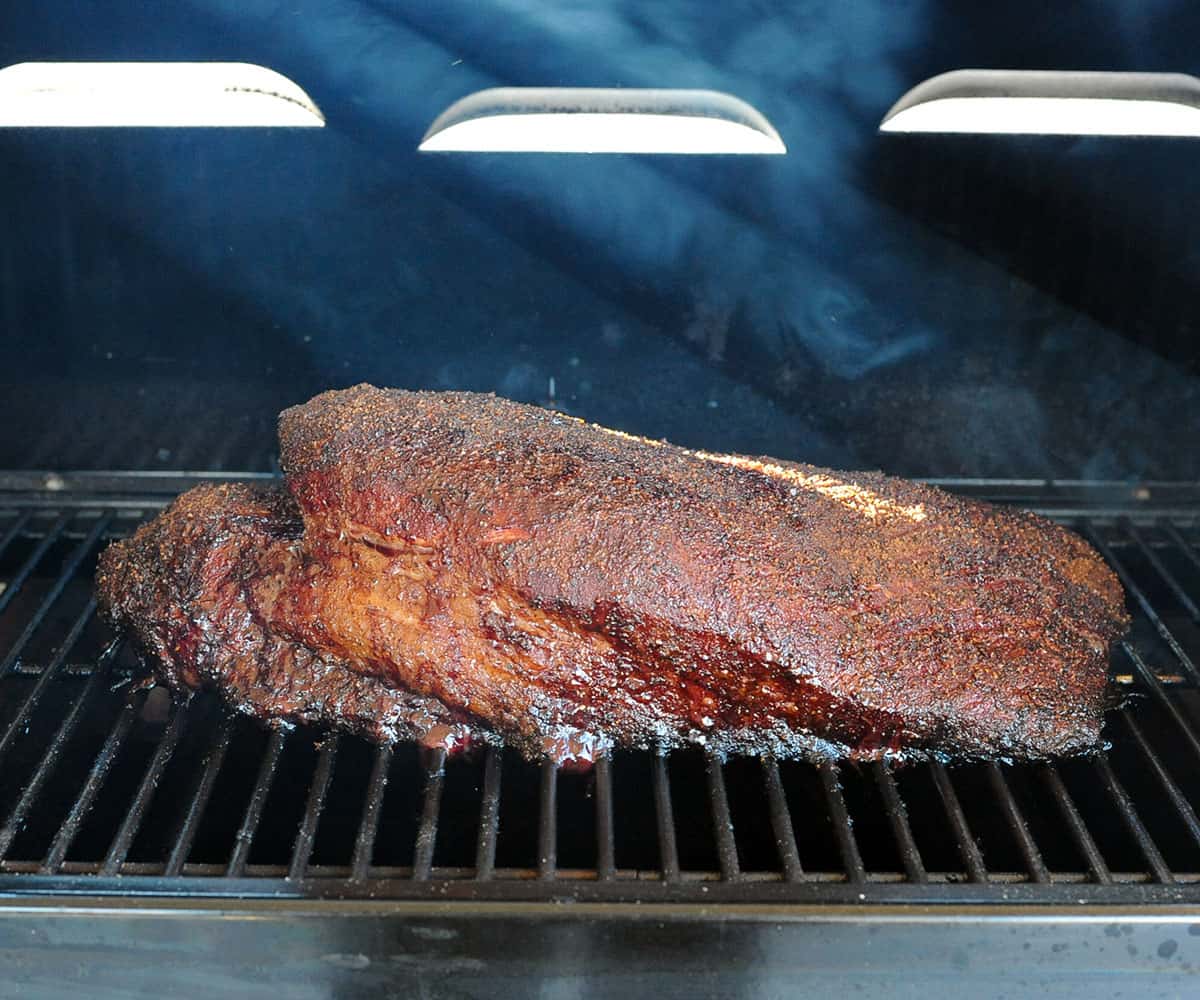
How to smoke a brisket on a pellet grill
One of the easiest ways to BBQ beef brisket is on a pellet grill, like a Traeger or Green Mountain Grill.
Before getting started, make sure your grill is clean. Empty any ash from your fire pot and clean out your grease drip pan. It doesn’t hurt to add a sheet of clean foil on top of your deflector plate either.
Then, simply load your hopper with wood pellets – I prefer a blend of post oak, cherry, pecan and/or hickory. And set your smoker to 225F degrees. This is a long cook, so make sure your hopper is full.
Once your brisket is trimmed, seasoned and rested, place it on the pellet grill with the fat side down. Place the point end of the brisket toward the hopper.
Spritz it with apple cider vinegar every two hours until it reaches an internal temperature of 160-165F degrees. Then, wrap the brisket in aluminum foil or peach paper.
Return the wrapped brisket to the smoker and let it continue cooking to a final temp of 200-205F degrees.
Check your hopper occasionally to make sure you have plenty of pellets.
How to smoke a brisket on a ceramic cooker
If you have a ceramic cooker like a Big Green Egg or Kamado Grill, plan ahead before selecting a brisket. These grills aren’t as wide as other grills, so make sure the brisket you buy isn’t going to be too long.
Light lump charcoal or charcoal briquets using either with a charcoal chimney or following the pyramid method.
Once the coals ash over add 3 wood chunks on top. Place the diffuser plate in the grill and add the grill grate. Adjust the top and bottom vents, until the grill stays steady at 225F degrees.
Add the prepared brisket to the smoker with the fat facing down. Spritz with apple cider vinegar every two hours and smoke to an internal temp of 160-165F degrees.
When you remove the brisket from the smoker, check the coals. Add more if needed, because you still have a few hours of cook time to go.
Once you wrap the smoked brisket, return it to the smoker and continue cooking it to a final temp of 200-205F degrees.
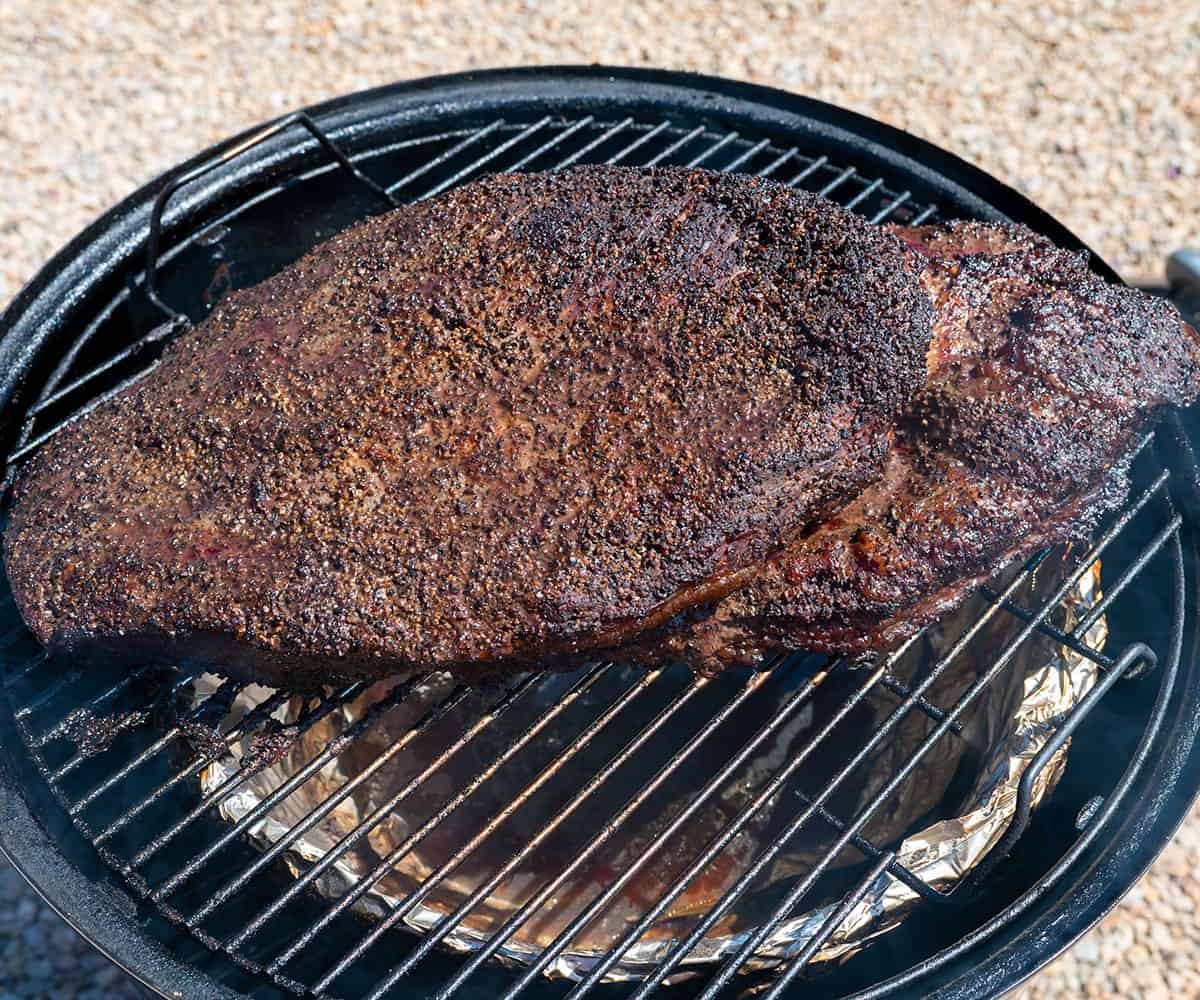
How to smoke a brisket on a vertical smoker or drum smoker
If you’re using a vertical smoker like a Weber Smokey Mountain or a Hunsaker Drum Smoker, the technique is similar to the ceramic cooker (above).
However, instead of adding a diffuser plate, you’ll add a water pan. The Weber Smokey Mountain comes with a water pan in the middle level. Fill that with warm water.
For the Hunsaker, place one rack lower in the grill and add an aluminum pan filled with warm water. Place another grate on the top level.
It’s important that you use warm or hot water. If you use cool water, you’ll bring your grill temp down too low.
For competitions, I smoke my briskets on my Hunsaker using the hot and fast method.
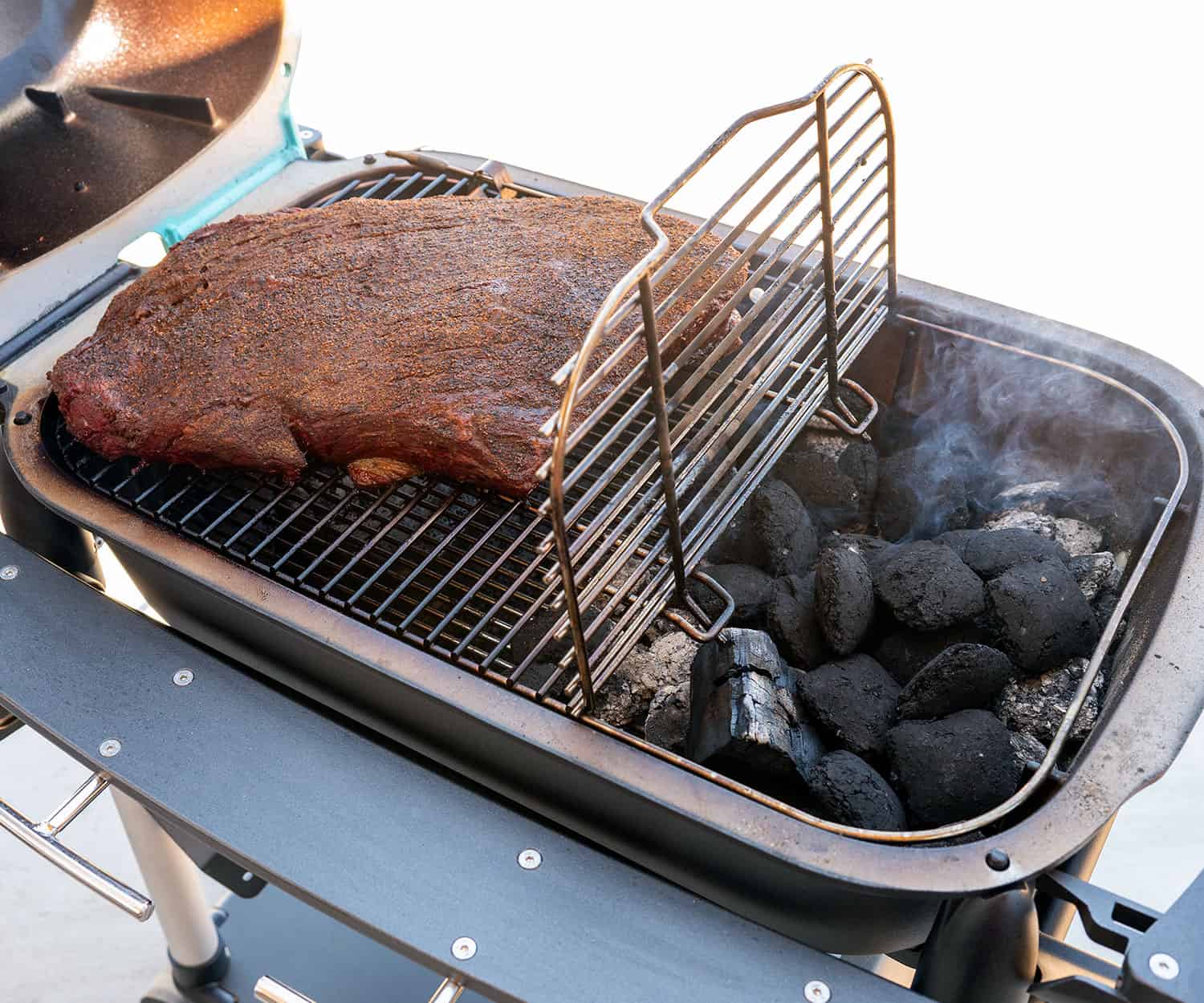
How to smoke a brisket on a charcoal grill
If you’re using a charcoal grill like a classic Weber kettle or a PK Grill, you’ll need to create an indirect heat zone.
When you light your coals, they’ll be pushed to one side of the grill and the brisket will be placed over the side without coals. Because of this, you’ll need to make sure your brisket isn’t too large.
Once the coals ash over, add 3 wood chunks and adjust the vents, so the grill hums at 225F degrees.
Add the brisket to the grill over the side without coals with the fat side down and the point facing the coals.
Smoke spritzing every two hours, until the internal temperature reaches 160-165F degrees. You’ll need to keep an eye on your grill temperature and add more coals as they start to burn out.
Wrap the smoked brisket and return the wrapped brisket to the grill, cooking to an internal temp of 200-205F degrees.
How to smoke brisket on a gas grill
Believe it or not, you can actually smoke a beef brisket on a gas grill. It won’t get the same amount of smokiness, nor will it get a smoke ring, but it’s still possible.
This works best if you have a 3-4-burner grill. Start by turning one of the edge burners on medium-low. Close the lid.
Monitor the temp of your grill. You want it to reach 225F degrees. Adjust the dial, as needed.
Create a foil pouch filled with wood chips or pellets and place it on the side of the grill where the burner is on. It will start to smoke. Have a few pouches on stand by, because one pouch won’t last the full cook.
Add your brisket to the grill over the burners that are turned off with the fat side down and the point end facing the side of the grill where the burner is on.
Cook spritzing every 2 hours with apple cider vinegar. Add more foil pouches as needed.
Once the brisket reaches 160-165F degrees, wrap it and return it to the grill. You don’t need to add any more foil pouches at this time.
Continue cooking to 200-205F degrees and let it rest.
How long to smoke a brisket
One of the most googled brisket questions is, “How long does it take to smoke a brisket?”
The answer for cook time will vary, depending on how much your brisket weighs, what temperature you’re cooking at and even your altitude and outside temperature.
I’ve had some briskets take 12 hours and some take 20. When you decide you want to smoke a brisket, I recommend adding it to the smoker early in the morning or even the night before.
For a general rule of thumb, an 11-pound brisket smoked at 225F degrees takes around 12 hours. That includes 6 hours before the wrap, 3 hours wrapped and a 3-hour rest.
I’ve included an infographic with a helpful timeline at the bottom of this post, so you can plan your cook step-by-step.
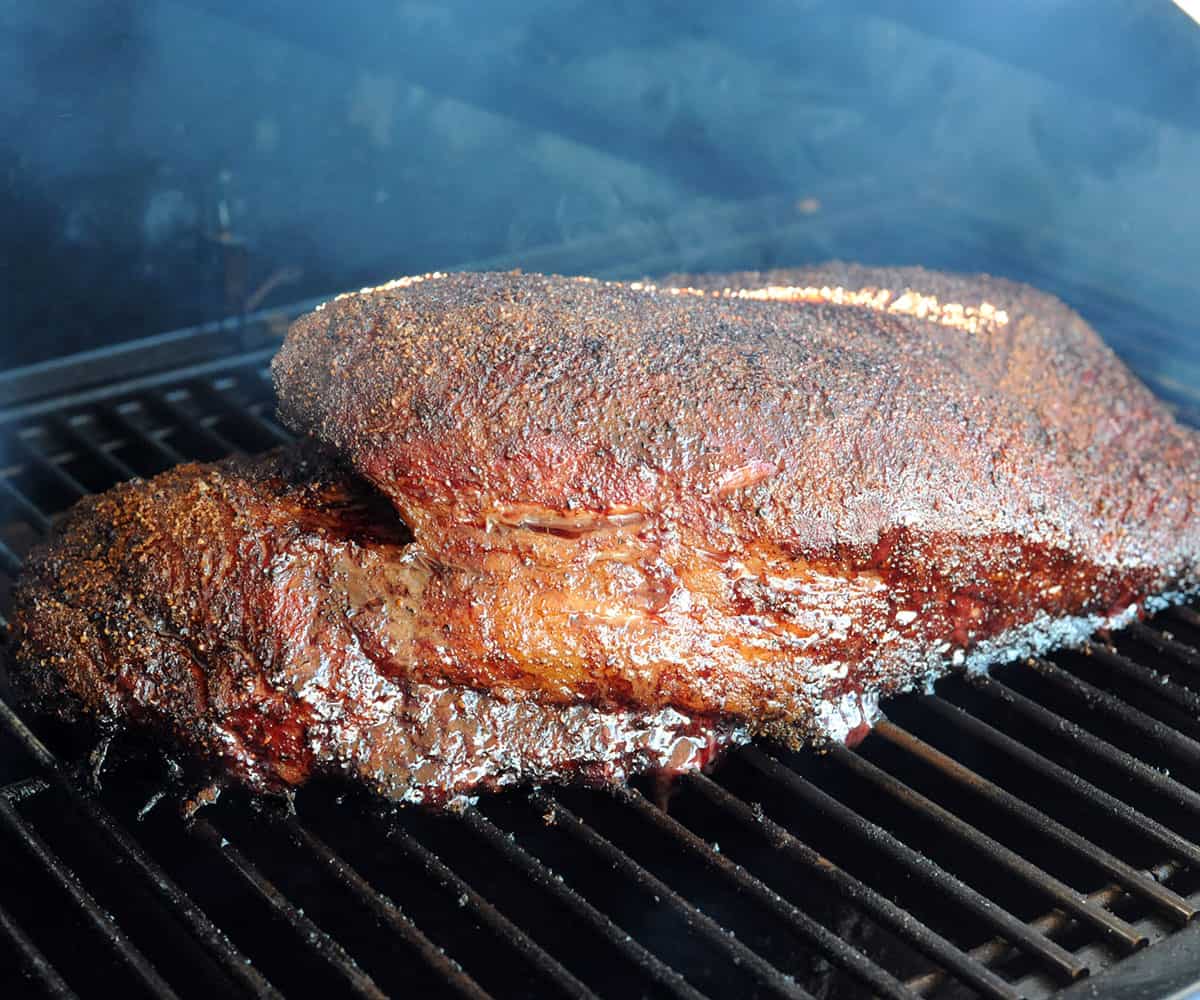
Temperature is more important than time
When smoking a brisket, it’s more important to focus on the color and temperature than it is to focus on the time.
Use a meat thermometer to monitor the temp of your meat throughout the cook instead of a timer. This will tell you when it’s time to move onto the next step.
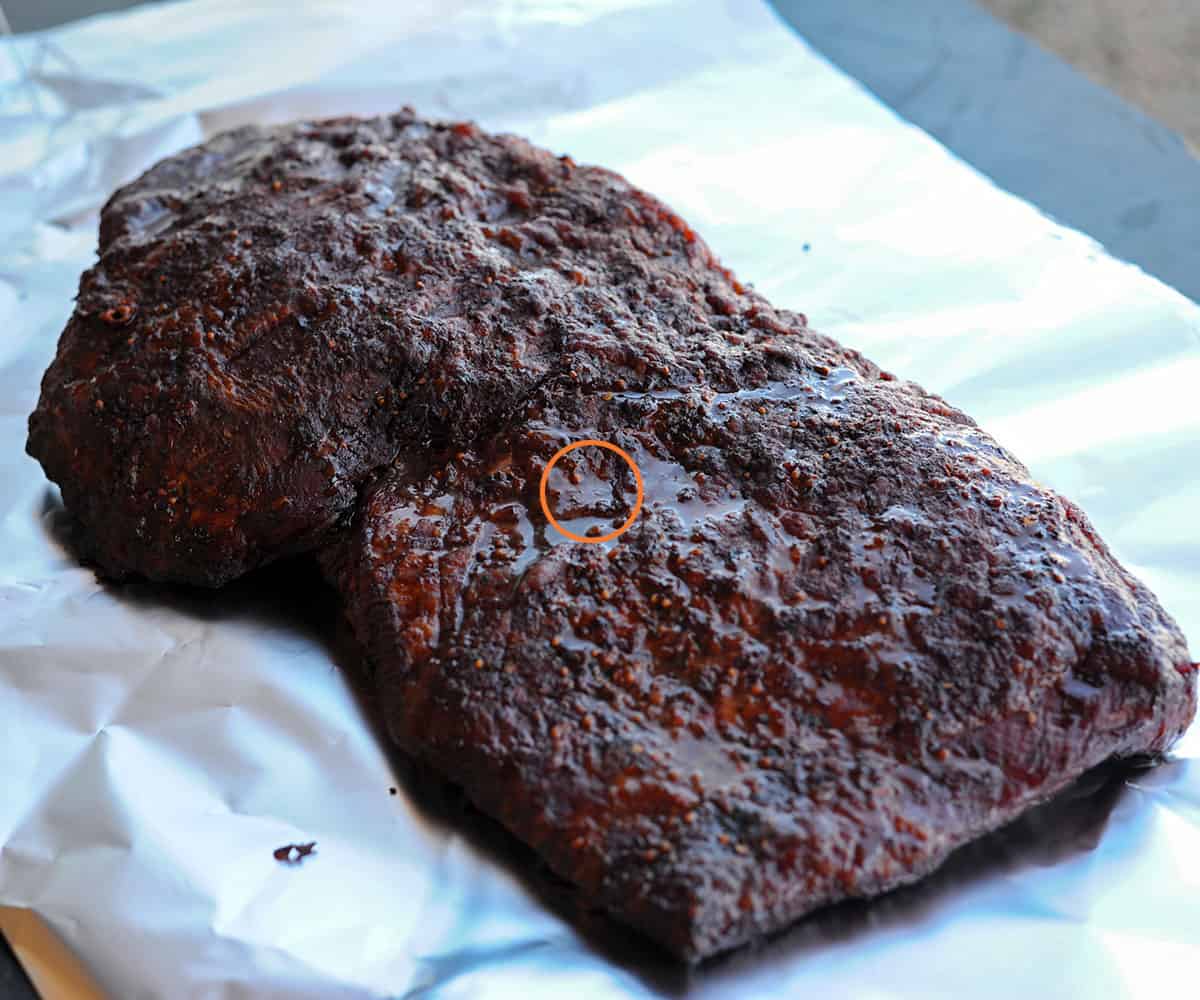
Where you put the temperature probe matters
The point part of the brisket will show a higher temp than the flat, because it’s fattier.
If you undercook your brisket flat, it will be dry; if you undercook the point, it could be chewy. When the flat is overcooked, it will shred apart like pot roast. If the point is overcooked, it will honestly still taste awesome.
So you can see the challenge. You can either insert two probes: one in the flat and one in the point.
Or you can insert one probe in the flat about an inch from where the point and flat meet. I have found this to be the ideal spot to get the best reading.
BBQ Tips: Mastering temp, color and feel >>
How to smoke a moist, juicy brisket
Several steps in this smoking process will lead to a moist, juicy brisket.
- The higher the grade of brisket you choose, the juicier your brisket will be
- Inject your brisket with broth or phosphates to help tenderize the meat
- Place a pan of water on the grill if you live in a dry climate
- Spritz the brisket throughout the cook to aid moisture
- Once the meat reaches the stall, wrap it to lock in moisture
- Allow your brisket to rest after the cook so the juices redistribute into the meat
I live in the desert at a fairly low altitude, so I always place a disposable pan of water in my grill while I’m smoking a brisket. This creates steam in the smoker.
I also spritz the brisket throughout the cook with apple cider vinegar. This not only helps to create a flavorful bark, but it also introduces additional moisture in the grill.

Smoked beef brisket internal temps
There are two main temperature goals that you’re looking for:
- Wrap Temp: 160-165F degrees
- Finish Temp: 200-205F degrees
When the brisket reaches 160-165F degrees, you’ll notice that the temperature will stop increasing as quickly. This is called the brisket stall.
At this point, water is evaporating from the brisket. The evaporation process takes precedence over the cooking, so the meat temperature won’t rise as quickly.
As long as you’re loving the color of your bark – it should be a dark mahogany – then, you can use the Texas crutch to break through the stall.
Spritz the brisket one more time and wrap the brisket tightly in two layers of foil or peach butcher paper.
Foil vs. Peach Paper: Foil is easier to come by and does a great job at locking in moisture, but people enjoy using peach paper because it allows some moisture to escape, preserving the beautiful bark you created.
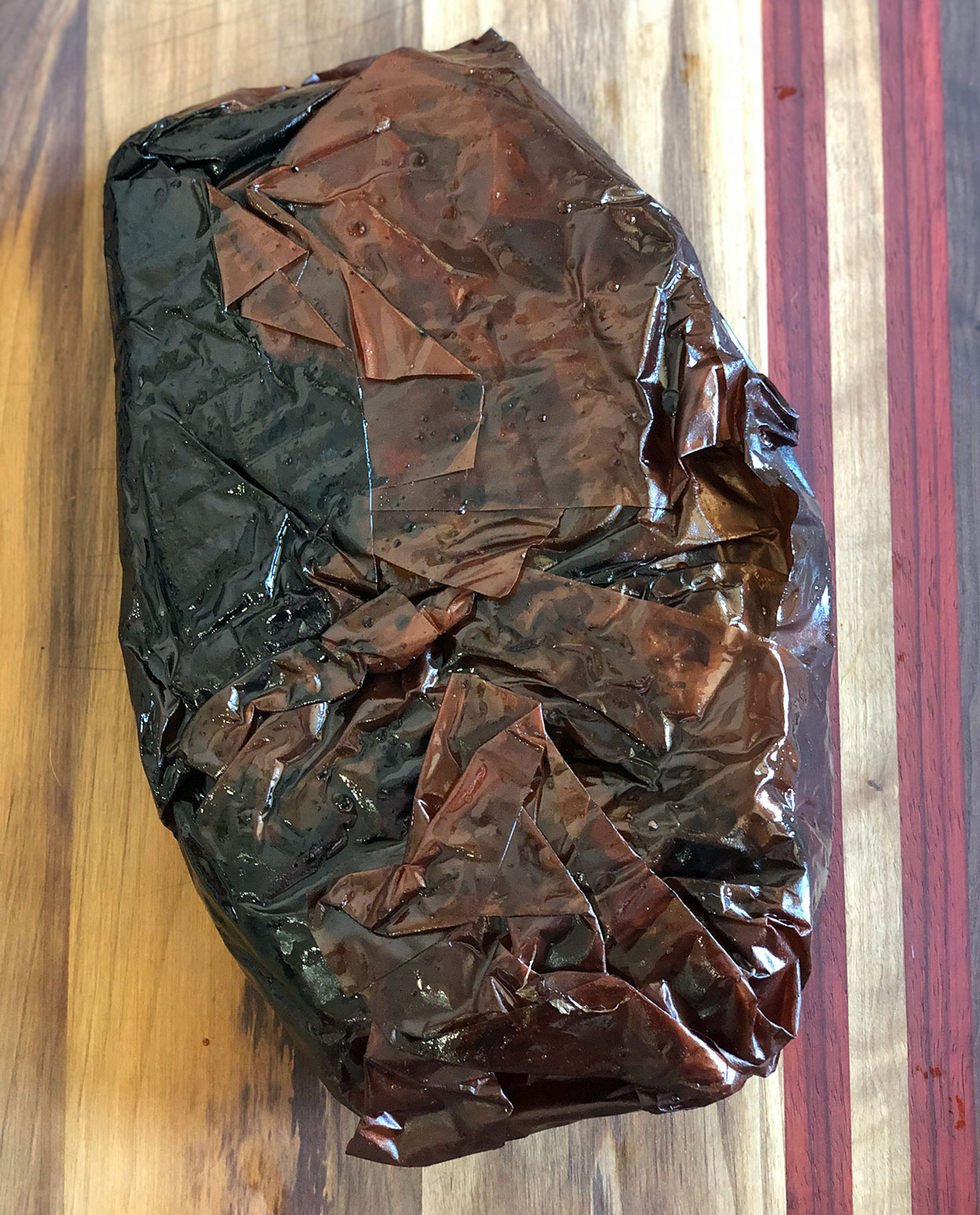
You want to keep that thermometer in the meat, because this next temp is the most important part.
Continue cooking the brisket, until your meat temperature reaches 200-205F degrees. Some competition diehards swear by 203F degrees, to be exact. For an 11-pound brisket, this can take another 3 hours.
PRO TIP: The best way to test the doneness of your brisket is to pierce the probe into the meat in multiple spots. If it glides in like butter with little resistance, it's ready.
Factors that can effect the best final brisket temperature
The goal of 200-205F degrees works for most people cooking choice or prime briskets at average altitudes.
If however, you are cooking a highly marbled brisket like a Snake River Farms gold, I recommend increasing that final temp to 207-214F degrees.
If you don’t allow the internal fat to completely render, your bites can end up a little chewy, especially in the point.
Another factor that impacts the final temp is your altitude. If you live at a higher altitude, your brisket will not only cook faster, but your final temp will be lower.
3 Rocky Mountain Pitmasters Share How to Barbecue at High Altitudes >>
Let your brisket rest
After all of that hard work, I can’t stress how important this step is. You have to rest your brisket. Just think of this as part of the cooking process.
There’s a whole lot of science behind why this step is important, but to keep things simple –> this helps lock in the juicy flavor. Any step that locks in flavor is a good one. Right?
Remove your brisket from the smoker. Wrap it in one more piece of foil. Then, wrap it in a towel, and place it in a large cooler (without ice) for at least 3 hours.
If you only rest it for 1-2 hours, your brisket will still be good. It’ll just be a little better if you go the full 3 hours.
BBQ Tips: Why is resting brisket important >>
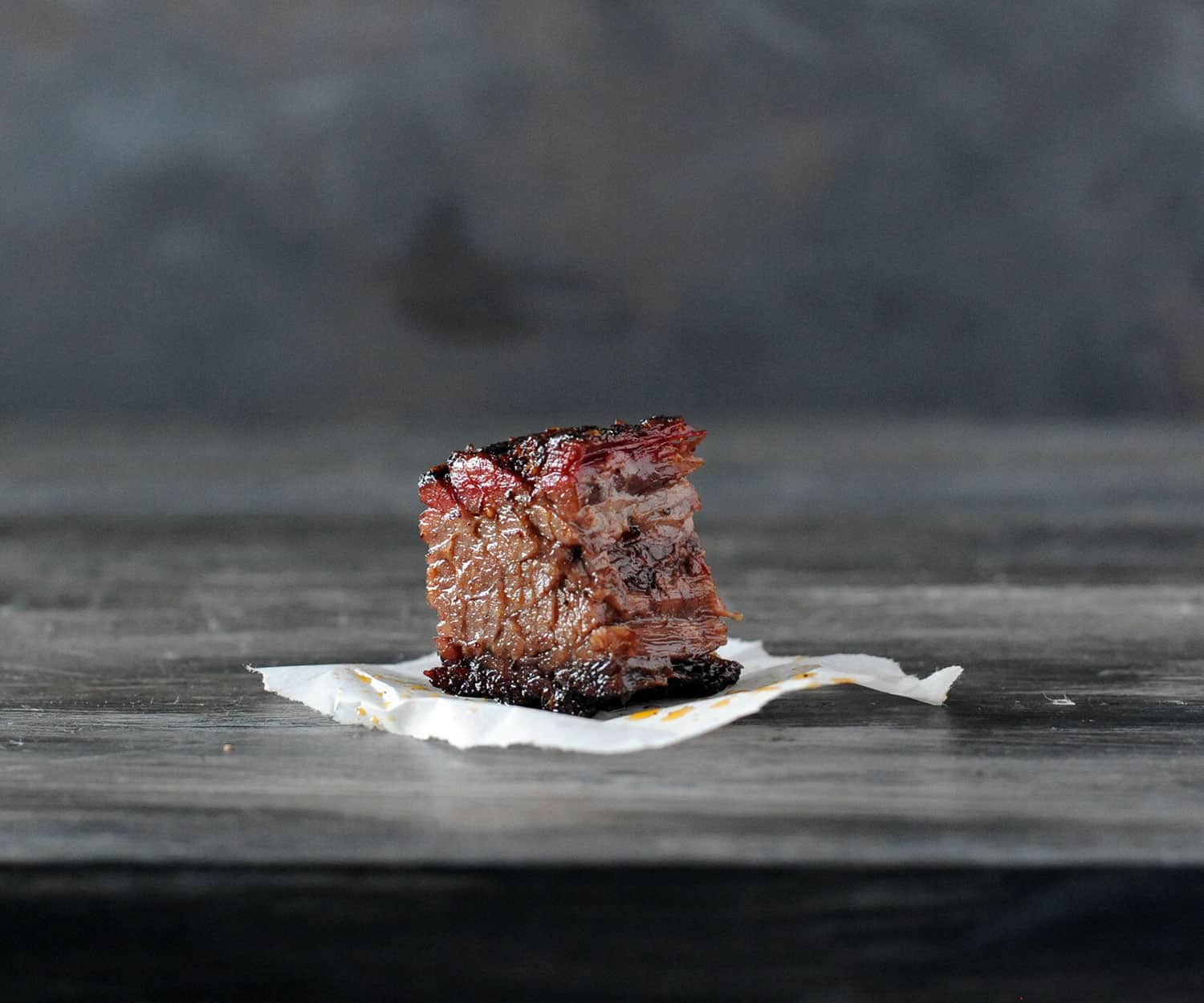
How to make burnt ends
Okay. At this point, you’ve been so disciplined and patient, but there is one more magical step for the best bites of brisket. Reheat your smoker to 275F degrees.
Remove the smoked brisket from the cooler and foil, and cut the flat end off. Wrap him back in foil, and return him to the cooler.
Cut the point end into one-inch chunks. Throw them in an aluminum pan, and gently toss them with more rub and your favorite BBQ sauce.
Place the pan back on the smoker. Smoke for 1 hour to set the sauce.
How to slice brisket
During the last 15 minutes of smoking the burnt ends, pull the flat out of the cooler, and slice it against the grain, using a long serrated knife.
Remember during the trim section of this post we created a little notch in the corner. That was our guide. Just continue slicing the meat following that guide.
A sign of a well-cooked brisket flat is it’s flexibility. If you can bend sliced smoked brisket over your finger, congratulations!

If it feels a little tight, that’s okay, just make your slices a little thinner.
For a finishing touch, sprinkle the slices with more rub and brush with remaining juices.
Finally, remove the burnt ends from the smoker and serve the crowd.
If you follow these smoked brisket recipe tips and techniques, you should end up with the juiciest most flavorful brisket you’ve ever smoked.
GCG Pro Pitmaster Tips
- Choose the highest quality brisket you can afford
- Maintain a steady grill temp throughout the cook
- Use a meat thermometer to manage the critical temps
- Wrap the brisket to speed up cooking and lock in moisture
- Don’t skip the rest step
- Don’t get discouraged; you’ve got this
Frequently Asked Questions
If you followed all of these steps, you should end up with a moist brisket. If it is dry you probably didn’t cook it long enough or with enough moisture.
For a lower-grade beef, injecting your brisket will help, as will spritzing it, wrapping it and letting it rest. Another method you can use to add moisture is to pour a liquid mop (like beef broth or tallow) into your wrap.
If you have tried all of this and are still having problems, leave a comment below and I’ll help you troubleshoot.
Well, you can cook a brisket in the oven, but you can’t get smoke flavor in the oven, because your oven doesn’t have a smoke source.
Follow the same steps as the recipe outlines, setting your oven temperature to 225F degrees. Use a leave-in meat thermometer in during the cook. When it reaches 165F degrees, follow the Texas crutch method.
Then, continue cooking it and resting it following the rest of the recipe.
Technically, a brisket is done smoking at the wrap stage. So if you want, you can start by smoking it on a grill. Then, once you wrap it, you can finish cooking it in a 225F-degree oven.
USDA recommends eating smoked brisket within 3-4 days, if it’s kept in an airtight container in the refrigerator. If you freeze it, it will taste best if eaten within 3 months.
If you are serving it and it’s sitting on the counter, it shouldn’t stay out for longer than two hours.
If you’re just reheating a couple of slices of brisket, place them on a plate, cover them with a damp paper towel and heat in the microwave in 30-second intervals.
If you’re heating a large batch, place the slices in a pan, add a bit of beef broth, cover it and place it in a 250-degree oven until warmed through.
What to serve with smoked beef brisket
Honestly for me, the best sides to serve with smoked brisket are a couple slices of white bread and some pickles, but if you’re serving a crowd, here are some of my other faves.
If you have leftover brisket, you can shred the meat and serve it in tacos, on nachos on loaded baked potatoes, in savory hand pies or even fried up in an omelet.
Want even more great grilling recipes and tips? Subscribe to my newsletter and follow me on Facebook, Instagram and TikTok for my latest grilling adventures. If you make a recipe, please leave a comment and rating below.
Save this BBQ Tip
Enter your email, and I’ll send this link directly to your inbox. Plus, you’ll get new BBQ recipes and tips weekly.
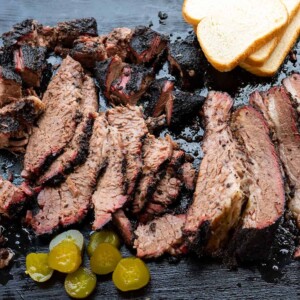
Smoked Brisket
Ingredients
- 11 lb brisket
- 1 cup beef broth
- 1/3 cup brisket rub or SPG
- apple cider vinegar
Instructions
- Trim: Trim excess fat from the brisket.
- Inject + Rub: Inject the brisket with beef broth. Rub it liberally with brisket rub or SPG. Cover and refrigerate overnight.
- Heat Smoker: Set the smoker to 225F degrees with your favorite charcoal, wood chunks or pellets.
- Smoke: Smoke fat side down, spritzing with apple cider vinegar every two hours, until a thermometer placed in the flat end of the meat measures 160-165F degrees. Make sure the smoker maintains a steady temp.
- Wrap: Spritz the brisket one more time, and tightly wrap it in two layers of foil.
- Finish Cooking: Continue smoking until the brisket is around 203F degrees.
- Rest: Wrap in another piece of foil and a towel, and place it in a cooler (without ice) for at least 3 hours.
- Slice: Slice the brisket against the grain and serve.
Video
Notes
Nutrition
Nutrition information is automatically calculated, so should only be used as an approximation.
Here’s a handy Girls Can Grill infographic to make things easier for you.
Click the image below to download a pdf of the infographic.
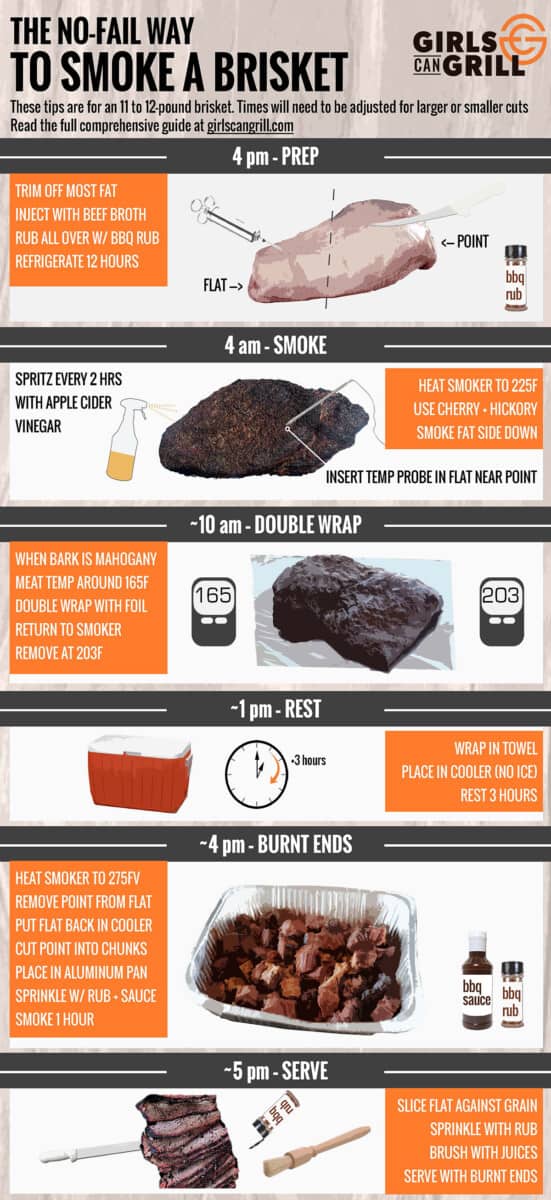

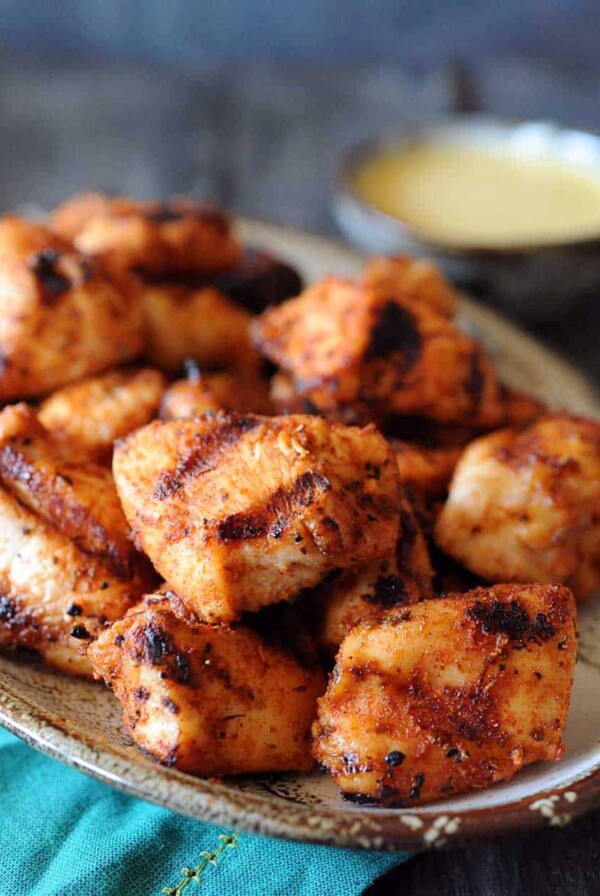
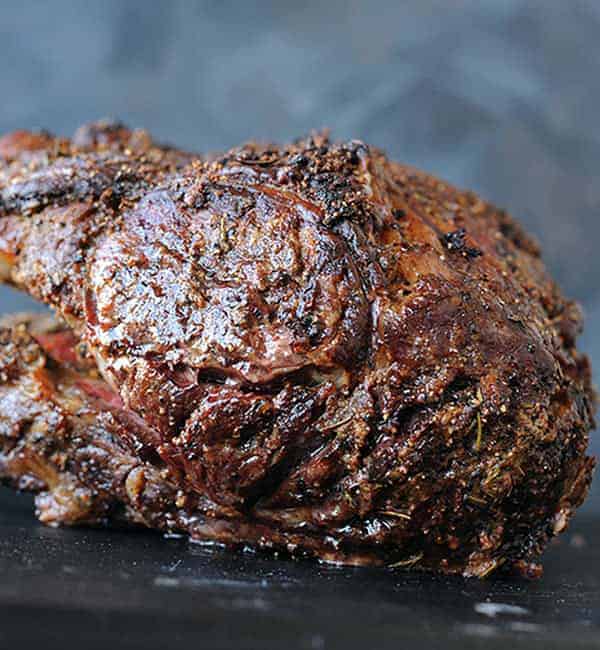
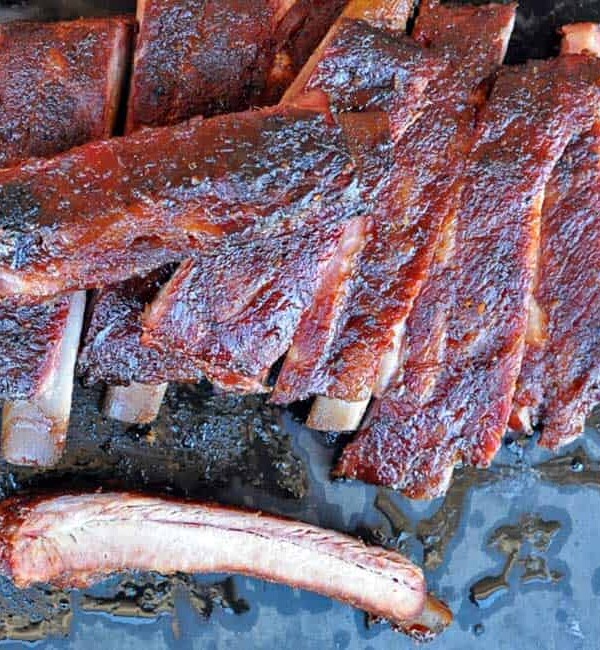
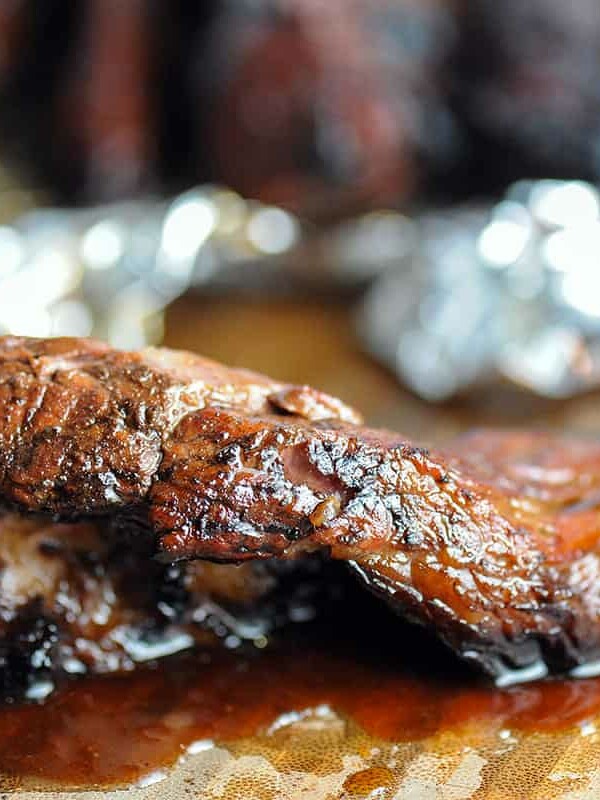
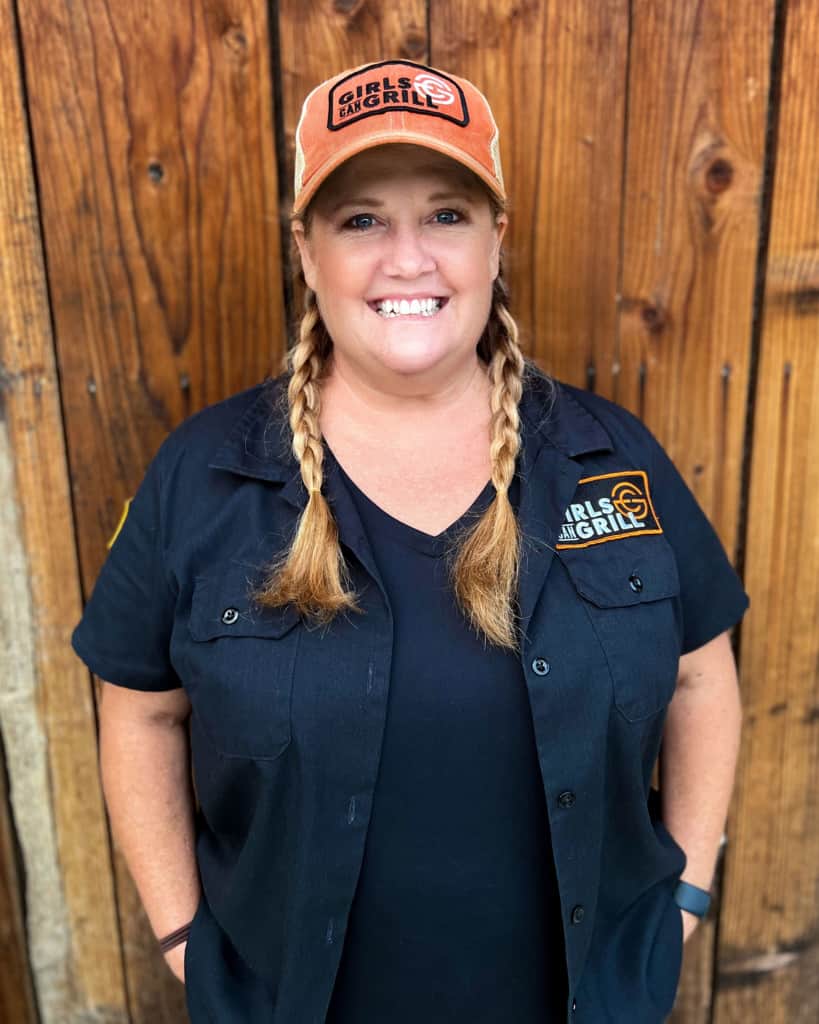








I was going to cut off the flat and grind it into burger along with beef fat. Is it OK to just cook the point? It is such a massive slab of meat it will take long time for us to eat all of it. I know I won’t have the competition pieces from the flat, but is it that critical?
Sure. That’s totally fine. Ground brisket makes awesome burgers.
I tend to use my kamado with blocks of wood. The pellet grill never seems to infuse the deeper smoke flavors and that is with 2 of the smoke tubes inside to try and help it out. Hoping this long cook recipe on pellet will help compensate. Looking forward to the idea of set temp and walk away for several hours. PS: We saw you on first episode of BBQ Brawls and were so glad you kicked but on the Tri Tip especially with 2 other self pro-claimed experts that didn’t appear to come close your result. Well done! Keep it up.
Pellet grills will never fully taste like cooking with charcoal and wood chunks, but if you use them at a lower temperature, they do produce more smoke. Hopefully, it creates the taste you’re looking for. Thanks for watching BBQ Brawl.
I smoked an 11 pound brisket. I removed the point and smoked that separately, so I could make burnt ends for the first time. I’ve smoked briskets before but never made the burnt ends. That was so easy, and they were a bigger hit than the sliced brisket (which was also great). The brisket took a LONG time. I smoked for 14 hours and then rested. I had started at 3am (with a Traeger that wasn’t so bad, since I had everything prepped and just had to throw it on and push a button). I was getting a bit nervous though as dinner time was getting nearer. So I only had a bit over an hour of resting, but it was juicy and tender, so all’s good. Thanks for the easy to follow directions!
Awesome! I love hearing about everyone’s success.
Your smoked brisket recipe is a true gem! The detailed instructions and insightful tips make it accessible even for novice grillers like me. The bark’s rich flavor and the tenderness you’ve achieved are a testament to your mastery. Thanks for empowering us to create a mouthwatering smoked brisket that’s a guaranteed crowd-pleaser. This recipe will undoubtedly become a staple in my grilling repertoire. 🥩🔥👏
Very good brisket recipe. Very through. I have been cooking briskets for 50+ years but like to try others and you being a Texas woman made me pick you. Good work.
WARNING: YOUR FAVORITE CUTCO BUTCHER KNIFE IS DANGEROUS!! I HAVE ONE BUT RARELY USE IT BECAUSE THERE IS NO GUARD IN FRONT OF THE HANDLE TO PROTECT YOUR HAND FROM BEING SLICED IF THE KNIFE SLIPS. BE VERY CAREFUL USING IT.
Thanks for the feedback and for offering some safety advice.
Everything looks good.